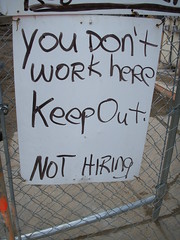Show Up or Stay Home
August 15th, 2011Some context…I recently stumbled into reading Primal Blueprint, credit the kindle and it’s easy ability to sample books. In that book, Mark talks about the idea of breakthrough performances. His thesis being that instead of toiling away at chronic cardio, you approach a workout like it will be your breakthrough performance. Whatever your current plateau is, if you don’t feel like you can smash through it with this next workout then take the day off and recover. Sounds like a recipe for couch surfing right? Well he suggests that instead of long workouts that break our bodies down, we focus on shorter ones that push our boundaries and allow plenty of time for recovery.
 I try to make my decisions about whether to do something physical based on that ‘rule’. Do I feel like I can put in a breakthrough performance? No? Then I don’t bother and instead allow for more recovery. This recovery could be mental, physical, injury based, lack of sleep, who knows but it’s a simple measure. Show up if you’re going to push your limits or don’t bother, ie recover. It’s a nice change from that feeling of just putting in the hours, grinding it out.
I try to make my decisions about whether to do something physical based on that ‘rule’. Do I feel like I can put in a breakthrough performance? No? Then I don’t bother and instead allow for more recovery. This recovery could be mental, physical, injury based, lack of sleep, who knows but it’s a simple measure. Show up if you’re going to push your limits or don’t bother, ie recover. It’s a nice change from that feeling of just putting in the hours, grinding it out.
The other subtle side effect here is getting you into the zone. If you did show up then you’ve now committed yourself to pushing your own limits. Otherwise, you shouldn’t be here.
All this got me thinking, what if we approached our workdays like this? Is it really any different than physical health? Show up to the office if you’re prepared for a personal breakthrough performance, otherwise stay away and allow yourself to recover until you’re ready to push through a plateau.
Why don’t we allow for more recovery in the context of work instead of the absurd three weeks vacation per year? How exciting would it be to spend your workdays pushing through personal plateaus instead of putting in the hours and grinding out another day? I’d be excited about working in an office knowing that the people here today are committed to pushing their limits. Contrast that to watching someone nod off at their desk or drag their ass into yet another meeting, well let’s not waste each other’s time.
PS: Who knows how this works in the context of essential services. It would suck to call 911 only to hear that no one in your area was prepared to have a breakthrough performance today….


 At
At 



